|
News Archive: April 1-30 |

|
Black holes may fill the universe with seeds of life
New research shows that black holes are not the ultimate destroyers that are often portrayed in popular culture. Instead, warm gas escaping from the clutches of enormous black holes could be one source of the chemical elements that make life possible.
 FULL STORY FULL STORY
 |  |

|
 |
OTHER HEADLINES Additional stories today
|
 |
Scientists discover vast intergalactic cloud of plasma -- Combining the world's largest radio telescope at Arecibo, Puerto Rico with a precision imaging, seven-antenna synthesis radio telescope at the Dominion Radio Astrophysical Observatory, a team of researchers has discovered a new giant in the heavens, a giant in the form of a previously undetected cloud of intergalactic plasma that stretches more than 6 million light years across.

Cosmologically speaking, diamonds may actually be forever -- If you've ever wondered about the ultimate fate of the universe, Lawrence Krauss and Robert Scherrer have some good news - sort of. In a paper, the two physicists show that matter as we know it will remain as the universe expands at an ever-increasing clip. That is, the current status quo between matter and its alter ego, radiation, will continue as the newly discovered force of dark energy pushes the universe apart.
|
 |
Cape Canaveral welcomes new Falcon 9 rocket family
A new breed of heavy-lift rockets developed privately by Space Exploration Technologies now has a launch pad at Cape Canaveral under a just-reached agreement with the Air Force that would see Falcon 9 boosters fly commercial missions to the International Space Station and deploy satellites from Florida.
 FULL STORY FULL STORY
 |  |

|
 |
Next solar cycle will likely start in March, NOAA says
The next 11-year cycle of solar storms will most likely start next March and peak in late 2011 or mid-2012 - up to a year later than expected - according to a forecast issued by the NOAA Space Environment Center in coordination with an international panel of solar experts.
 FULL STORY FULL STORY
 |  |

|
 |
OTHER HEADLINES Additional stories today
|
 |
Queen Elizabeth II to visit Goddard Space Flight Center -- Queen Elizabeth II and the Duke of Edinburgh will visit NASA's Goddard Space Flight Center in Greenbelt, Md., on Tuesday, May 8. The tour of Goddard is occurring near the end of the queen's visit to commemorate the 400th anniversary of the Jamestown settlement in Virginia.

Two important reviews for upcoming Hubble mission -- NASA managers have completed two key program reviews that demonstrated the space shuttle servicing mission to the Hubble Space Telescope is progressing well. The STS-125 servicing mission to the telescope is targeted for launch in September 2008.

Lockheed to add signal to modernized GPS satellite -- The U.S. Air Force has awarded Lockheed Martin a $6 million contract to develop and integrate a demonstration payload that will temporarily transmit a third civil signal on a modernized Global Positioning System Block IIR (GPS IIR-M) satellite.

ILS, Telesat Canada sign contract to launch Nimiq 5 -- International Launch Services will launch its sixth satellite for Telesat Canada on a Proton Breeze M vehicle. The Nimiq 5 is scheduled for launch in 2009 from the Baikonur Cosmodrome in Kazakhstan.
|
 |
Climate catastrophes in the Solar System
Earth sits between two worlds that have been devastated by climate catastrophes. In the effort to combat global warming, our neighbours can provide valuable insights into the way climate catastrophes affect planets.
 FULL STORY FULL STORY
 |  |

|
 |
Satellites show impact of clouds on polar regions
Far beyond signaling the day's weather, clouds play a key role in regulating and understanding climate. A team of researchers recently completed a project to confirm what NASA satellites are telling us about how changes in clouds can affect climate in the coldest regions on Earth.
 FULL STORY FULL STORY
 |  |

|
 |
Station crew plans changed as shuttle repairs continue
Repairs to the shuttle Atlantis' hail-damaged external fuel tank are going relatively smoothly, with the first of two large-area foam sprays scheduled to begin as early as Sunday. While rollout to launch pad 39A has slipped several days to around May 15, NASA managers say a launch June 8 is still possible, although the schedule is very tight. Managers also approved a plan to bring space station astronaut Sunita Williams back to Earth aboard Atlantis.
 FULL STORY FULL STORY
 |  |

|
 |

 VIDEO:
HOUSTON TELLS SUNI WILLIAMS THE NEW PLAN PLAY VIDEO:
HOUSTON TELLS SUNI WILLIAMS THE NEW PLAN PLAY
 SUBSCRIBE NOW SUBSCRIBE NOW

|
Hawking enjoys zero G
Physicist Stephen Hawking, the wheelchair-bound theorist known for his insights into the nature of black holes and gravity, experienced weightlessness Thursday during an eagerly anticipated airplane ride off Florida's East Coast.
 FULL STORY FULL STORY
 |  |

|
 |
Satellite to unveil secrets of Earth's highest clouds
NASA has launched a clue-seeking satellite to track eerily mysterious clouds at the threshold of space that some scientists believe are the harbingers of global climate change.
 FULL STORY FULL STORY
 MISSION STATUS CENTER MISSION STATUS CENTER
 |  |

|
 |

 VIDEO:
AIM LAUNCHED ABOARD PEGASUS ROCKET PLAY VIDEO:
AIM LAUNCHED ABOARD PEGASUS ROCKET PLAY
 VIDEO:
LONGER LENGTH MOVIE OF ENTIRE FLIGHT TO ORBIT PLAY VIDEO:
LONGER LENGTH MOVIE OF ENTIRE FLIGHT TO ORBIT PLAY
 VIDEO:
POST-FLIGHT INTERVIEW WITH NASA LAUNCH MANAGER PLAY VIDEO:
POST-FLIGHT INTERVIEW WITH NASA LAUNCH MANAGER PLAY

 VIDEO:
NARRATED MOVIE OF AIM'S PRE-FLIGHT PREPARATIONS PLAY VIDEO:
NARRATED MOVIE OF AIM'S PRE-FLIGHT PREPARATIONS PLAY
 VIDEO:
NARRATED MOVIE OF PEGASUS' LAUNCH CAMPAIGN PLAY VIDEO:
NARRATED MOVIE OF PEGASUS' LAUNCH CAMPAIGN PLAY
 VIDEO:
PRE-LAUNCH NEWS CONFERENCE PLAY VIDEO:
PRE-LAUNCH NEWS CONFERENCE PLAY
 VIDEO:
AIM MISSION SCIENCE PREVIEW PLAY VIDEO:
AIM MISSION SCIENCE PREVIEW PLAY
 SUBSCRIBE NOW SUBSCRIBE NOW

|
Japan's asteroid explorer begins voyage back to Earth
A small Japanese asteroid probe riddled by a streak of bad luck began its slow limp home Wednesday, but officials still face a myriad of challenges to bring the craft back in 2010.
 FULL STORY FULL STORY
 |  |

|
 |
Pre-launch ops keep crews busy at the Cape
Crews at Cape Canaveral Air Force Station are busily processing flight hardware and gearing up for a number of Atlas and Delta rocket launches through the rest of the year.
 FULL STORY FULL STORY
 |  |

|
 |
Astronomers find first habitable Earth-like planet
Astronomers have discovered the most Earth-like planet outside our Solar System to date, an exoplanet with a radius only 50 percent larger than the Earth and capable of having liquid water.
 FULL STORY FULL STORY
 |  |

|
 |
Missile research craft soars into space from Virginia
A data-gathering research satellite for the U.S. missile defense program successfully launched into space from the Virginia coast aboard an Orbital Sciences Minotaur 1 rocket early Tuesday morning.
 FULL STORY FULL STORY
 |  |

|
 |
Hubble sees extreme star birth in the Carina Nebula
One of the largest panoramic images ever taken with Hubble's cameras has been released to celebrate the 17th anniversary of the launch and deployment of the space telescope. The image shows a 50 light-year-wide view of the tumultuous central region of the Carina Nebula where a maelstrom of star birth - and death - is taking place.
 FULL STORY FULL STORY
 |  |

|
 |
XMM-Newton pinpoints intergalactic polluters
Warm gas escaping from the clutches of enormous black holes could be the key to a form of intergalactic 'pollution' that made life possible, according to new results from ESA's XMM-Newton space observatory.
 FULL STORY FULL STORY
 |  |

|
 |
NASA spacecraft make first 3-D images of Sun
NASA's twin Solar Terrestrial Relations Observatory (STEREO) spacecraft have made the first three-dimensional images of the Sun. The new view will greatly aid scientists' ability to understand solar physics and thereby improve space weather forecasting.
 FULL STORY FULL STORY
 |  |

|
 |

 VIDEO:
SCIENTISTS NARRATE 3-D IMAGES DURING BRIEFING PLAY VIDEO:
SCIENTISTS NARRATE 3-D IMAGES DURING BRIEFING PLAY
 SUBSCRIBE NOW SUBSCRIBE NOW

|
Indian rocket launches Italian space telescope
An Italian gamma ray observatory hitched a ride to space aboard an Indian rocket Monday, beginning a three-year mission to survey the sky in a search for faraway sources of the Universe's most energetic form of light.
 FULL STORY FULL STORY
 |  |
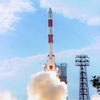
|
 |
Pegasus rocket mated to jet for NASA mission
Over the weekend at California's Vandenberg Air Force Base, an Orbital Sciences Pegasus rocket was attached to the underside of its L-1011 carrier aircraft for Wednesday's scheduled launch. The air-dropped booster will haul NASA's AIM satellite into orbit to study clouds. Launch time is targeted for approximately 1:26 p.m. local time (2026 GMT).
 |  |

|
 |
Space station crew safely returns to Earth
A record-setting NASA astronaut, his Russian cosmonaut crewmate and a billionaire American tourist left the International Space Station and returned to Earth on Saturday morning, landing on the steppes of central Asia inside their parachute-equipped descent capsule.
 FULL STORY FULL STORY
 MISSION STATUS CENTER MISSION STATUS CENTER
 IMAGES: CREW AFTER LANDING IMAGES: CREW AFTER LANDING
 PREVIEW STORY PREVIEW STORY
 |  |

|
 |


 VIDEO:
AERIAL FOOTAGE OF TOUCHDOWN PLAY VIDEO:
AERIAL FOOTAGE OF TOUCHDOWN PLAY
 VIDEO:
SOYUZ UNDOCKS FROM STATION PLAY VIDEO:
SOYUZ UNDOCKS FROM STATION PLAY
 VIDEO:
EXPEDITION 14 CREW BOARDS SOYUZ PLAY VIDEO:
EXPEDITION 14 CREW BOARDS SOYUZ PLAY
 VIDEO:
FAREWELL CALL FROM RUSSIAN OFFICIALS PLAY VIDEO:
FAREWELL CALL FROM RUSSIAN OFFICIALS PLAY
 VIDEO:
CHANGE OF COMMAND CEREMONY PLAY VIDEO:
CHANGE OF COMMAND CEREMONY PLAY
 MORE: EXPEDITION 14 COVERAGE MORE: EXPEDITION 14 COVERAGE
 MORE: LAUNCH OF EXPEDITION 15 MORE: LAUNCH OF EXPEDITION 15
 SUBSCRIBE NOW SUBSCRIBE NOW

|
Tragic shooting at NASA's Johnson Space Center
A NASA contract worker killed a hostage before shooting himself inside Building 44 at the Johnson Space Center Friday afternoon, police said. A second hostage escaped with minor injuries.
 FULL STORY FULL STORY
 |  |
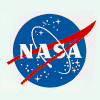
|
 |
NASA links earthquakes and boosting volcanoes
Scientists using NASA satellite data have found strong evidence that a major earthquake can lead to a nearly immediate increase in regional volcanic activity.
 FULL STORY FULL STORY
 |  |

|
 |
Tsunamis in space
Cluster is providing new insights into the working of a 'space tsunami' that plays a role in disrupting the calm and beautiful aurora, or Northern Lights, creating patterns of auroral dances in the sky.
 FULL STORY FULL STORY
 |  |
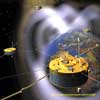
|
 |
Astronomers map out planetary danger zone
Astronomers have laid down the cosmic equivalent of yellow "caution" tape around super hot stars, marking the zones where cooler stars are in danger of having their developing planets blasted away.
 FULL STORY FULL STORY
 |  |

|
 |
Casting a shadow
Blazing like an icy torch, the plume of Enceladus shines in scattered sunlight as the moon casts a shadow onto Saturn's E ring. Some of the tiny ice particles erupted from the moon's south polar region go into Saturn orbit, forming the doughnut-shaped ring, onto which the moon's shadow is cast in this view from Cassini.
 FULL STORY FULL STORY
 |  |

|
 |
OTHER HEADLINES Additional stories today
|
 |
Orbital Express satellites separate, remate -- The two Defense Advanced Research Projects Agency (DARPA) Orbital Express spacecraft, launched March 8 in a mated configuration, successfully separated for the first time this week.

Space pros reflect on history of GPS satellite No. 15 -- A Boeing representative visited Schriever AFB recently to recall the history of GPS Satellite Vehicle Number 15 and join space professionals in a final farewell to the oldest GPS satellite in history. The craft had a rocky start before it got off the ground in 1990.

DMSP Flight 18 satellite completes vacuum test -- The next DMSP satellite, known as F-18, scheduled for launch in April 2008, has successfully passed a significant milestone this month when it completed a 10-day system level thermal vacuum test. This is the second DMSP satellite to be processed at the Lockheed Sunnyvale facility.
|
 |
NASA rethinking Williams' departure from station
NASA managers are reassessing whether to leave astronaut Sunita Williams aboard the international space station until August, a longer-than-planned stay because of a shuttle launch delay, or to bring her home aboard the Atlantis when flights resume in June, sources say.
 FULL STORY FULL STORY
 |  |
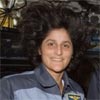
|
 |
Cosmic weight loss: The lowest mass white dwarf
Astronomers have found the lowest mass white dwarf known in our galaxy: a Saturn-sized ball of helium containing only about one-fifth the mass of the Sun. The source of the white dwarf's radical weight-loss plan is an unseen companion, likely another white dwarf, has sucked away much of the tiny white dwarf's material, leaving it a shadow of its former self.
 FULL STORY FULL STORY
 |  |

|
 |
Brown dwarfs: A new class
of stellar lighthouse
Brown dwarfs, thought just a few years ago to be incapable of emitting any significant amounts of radio waves, have been discovered putting out extremely bright "lighthouse beams" of radio waves, much like pulsars.
 FULL STORY FULL STORY
 |  |

|
 |
NASA picks shuttle launch dates for next 12 months
Space shuttle program officials have affirmed a new launch schedule to accomplish six flights over the next 12 months that will expand the space station to include the international science laboratory modules.
 FULL STORY FULL STORY
 |  |
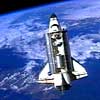
|
 |
Russian booster puts batch of small satellites into orbit
A Dnepr rocket laden with 14 small international satellites flew out of an underground missile silo and soared into space this morning on its first mission since failure struck the launcher last year.
 FULL STORY FULL STORY
 |  |
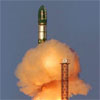
|
 |
OTHER HEADLINES Additional stories today
|
 |
NASA buys boosters for Orion abort flight tests -- NASA has entered into an agreement with the U.S. Air Force to provide launch vehicles for Orion ascent abort flight tests that are set to occur from 2009 through 2011 at the White Sands Missile Range in New Mexico.
|
 |
Was Einstein right? First look at Gravity Probe results
For the past three years a satellite has circled the Earth, collecting data to determine whether two predictions of Albert Einstein's general theory of relativity are correct. Over the weekend, the Gravity Probe-B principal investigator provided the first public peek at data that will reveal whether Einstein's theory has been confirmed by the most sophisticated orbiting laboratory ever created.
 FULL STORY FULL STORY
 |  |

|
 |
One year at Venus, and orbiter still going strong
One year has passed since Venus Express, Europe's first mission to Venus and the only spacecraft now in orbit around the planet, reached its destination. Since then, this advanced probe, born to explore one of the most mysterious planetary bodies in the Solar System, has been revealing planetary details never caught before.
 FULL STORY FULL STORY
 |  |

|
 |
OTHER HEADLINES Additional stories today
|
 |
Lunar surface charging: A hazard for astronauts? -- For four days every month the Moon passes through the magnetic field of the Earth and parts of the lunar surface are charged with static electricity. Dr Mike Hapgood of the Rutherford Appleton Laboratory will present a model at the Royal Astronomical Society National Astronomy Meeting in Preston, which suggests that this charging may increase after the year 2012 and become an important issue for future lunar explorers.

Did Herschel discover rings of Uranus in 18th Century? -- In a paper presented at the National Astronomy Meeting, Dr Stuart Eves of Surrey Satellite Technology Limited will challenge the orthodox view that the rings around the planet Uranus were first detected during an occultation experiment in 1977.
|
 |
Chinese rocket puts up navigational spacecraft
China launched its second satellite in less than three days Friday when a Long March 3A rocket successfully delivered a navigation craft into orbit. The three-stage booster left its payload in an egg-shaped transfer orbit with an inclination of 55 degrees.
 FULL STORY FULL STORY
 |  |

|
 |
Report reveals likely causes of Mars spacecraft loss
NASA's Mars Global Surveyor orbiter, which fell silent last November, appears to have succumbed to battery failure caused by a complex sequence of events involving the onboard computer memory and ground commands, investigators say.
 FULL STORY FULL STORY
 |  |

|
 |
Deep Impact could probe deeper into origins
In 2005, the Deep Impact spacecraft released a probe that blasted a crater in comet Tempel 1, spilling its elements into space so scientists could discover its composition. The assault was justified because comets are thought to be leftovers from the formation of our solar system, so learning more about them helps to understand how our solar system came to be. Now, a proposed extended mission for the spacecraft would observe the atmospheres of alien worlds, and to visit another comet.
 FULL STORY FULL STORY
 |  |

|
 |
Mystery of galaxy's spiral arms possibly explained
Using a quartet of space observatories, University of Maryland astronomers may have cracked a 45-year mystery surrounding two ghostly spiral arms in the galaxy M106, a stately spiral galaxy 23.5 million light-years away in the constellation Canes Venatici.
 FULL STORY FULL STORY
 |  |

|
 |
Are there purple palm trees on alien worlds?
A team of NASA scientists led by a member of the Spitzer Science Center believe they have found a way to predict the color of plants on planets in other solar systems. Green, yellow or even red-dominant plants may live on extra-solar planets.
 FULL STORY FULL STORY
 |  |

|
 |
Future space telescopes could detect Earth twin
For the first time ever, NASA researchers have successfully demonstrated in the laboratory that a space telescope rigged with special masks and mirrors could snap a photo of an Earth-like planet orbiting a nearby star. This accomplishment marks a dramatic step forward for missions like the proposed Terrestrial Planet Finder, designed to hunt for an Earth twin that might harbor life.
 FULL STORY FULL STORY
 |  |

|
 |
China launches an ocean observer spacecraft
China launched a satellite Wednesday to begin a three-year mission surveying the world's oceans to monitor sea color and temperature, according to state media reports. The Haiyang 1B satellite is China's second oceanographic satellite, and it replaces an earlier craft that stopped working in 2004.
 FULL STORY FULL STORY
 |  |

|
 |
Atlantis to fly with repaired fuel tank around June 8
Launch of the shuttle Atlantis on a hail-delayed flight to the international space station is slipping to no earlier than June 8, officials said Tuesday, to give engineers more time to repair damaged foam insulation on the ship's external fuel tank.
 FULL STORY FULL STORY
 MASTER FLIGHT PLAN MASTER FLIGHT PLAN
 MISSION QUICK-LOOK MISSION QUICK-LOOK
 |  |

|
 |
Dawn arrives in Florida
The Dawn spacecraft arrived at Astrotech Space Operations in Titusville, Florida, at 9 a.m. EDT Tuesday. Dawn, NASA's mission into the heart of the asteroid belt, is at the facility for final processing and launch operations. Dawn's launch period opens June 30.
 FULL STORY FULL STORY
 |  |

|
 |
Proton booster delivers Canadian satellite to space
Eleven years to the day since the Russian Proton rocket began flying under the marketing banner of International Launch Services, the heavy-duty booster overnight successfully heaved a 10,200-pound Canadian telecommunications satellite into Earth orbit.
 FULL STORY FULL STORY
 MISSION STATUS CENTER MISSION STATUS CENTER
 |  |

|
 |
Soyuz reaches station; NASA extends Russian deal
A Russian Soyuz spacecraft docked with the station Monday, delivering two new cosmonaut residents and an American tourist. NASA, meanwhile, announced a $719 million contract extension with the Russian federal space agency to, in part, provide the Soyuz lifeboats and supplies needed to eventually boost the station's crew size from three to six.
 FULL STORY FULL STORY
 MISSION STATUS CENTER MISSION STATUS CENTER
 |  |

|
 |

Additional coverage for subscribers:
 VIDEO:
SOYUZ DOCKS WITH THE STATION PLAY VIDEO:
SOYUZ DOCKS WITH THE STATION PLAY
 VIDEO:
HATCH OPENING AND SOYUZ CREW ENTERING STATION PLAY VIDEO:
HATCH OPENING AND SOYUZ CREW ENTERING STATION PLAY
 VIDEO:
VIPS INCLUDING MARTHA STEWART CALL THE CREW PLAY VIDEO:
VIPS INCLUDING MARTHA STEWART CALL THE CREW PLAY
 MORE: EXPEDITION 15 VIDEO INDEX MORE: EXPEDITION 15 VIDEO INDEX
 SUBSCRIBE NOW SUBSCRIBE NOW

|
Searching for the grandest asteroid tour
Asteroids are Earth's closest celestial neighbors, sometimes passing closer to Earth than even the Moon. And yet, to date, only two spacecraft have ever remained in proximity to one of these bodies. Last month, orbit mechanics experts from around the world met to discuss methods for finding the best possible spacecraft trajectory, or flight path, for visiting a sequence of asteroids.
 FULL STORY FULL STORY
 |  |

|
 |
Soyuz soars into orbit;
Docking set for Monday
Lighting up the night sky, a Russian Soyuz rocket carrying a wealthy American space tourist and two cosmonauts bound for the international space station blasted off from the Baikonur Cosmodrome in Kazakhstan Saturday and thundered safely into orbit.
 FULL STORY FULL STORY
 MISSION STATUS CENTER - live updates! MISSION STATUS CENTER - live updates!
 SOYUZ CAPSULE INFO SOYUZ CAPSULE INFO
 SOYUZ ROCKET INFO SOYUZ ROCKET INFO
 CREW PROFILES CREW PROFILES
 |  |

|
 |

Additional coverage for subscribers:
 VIDEO:
CREW DEPARTS QUARTERS ON LAUNCH MORNING PLAY VIDEO:
CREW DEPARTS QUARTERS ON LAUNCH MORNING PLAY
 VIDEO:
AFTER SUITING UP, CREW GOES TO THE PAD PLAY VIDEO:
AFTER SUITING UP, CREW GOES TO THE PAD PLAY
 VIDEO:
LAUNCH OF SOYUZ WITH EXPEDITION 15 PLAY VIDEO:
LAUNCH OF SOYUZ WITH EXPEDITION 15 PLAY
 VIDEO:
LONGER LENGTH MOVIE OF THE ENTIRE LAUNCH PLAY VIDEO:
LONGER LENGTH MOVIE OF THE ENTIRE LAUNCH PLAY
 VIDEO:
REPLAY FROM LAUNCH CAMERA 1 PLAY VIDEO:
REPLAY FROM LAUNCH CAMERA 1 PLAY
 VIDEO:
REPLAY FROM LAUNCH CAMERA 2 PLAY VIDEO:
REPLAY FROM LAUNCH CAMERA 2 PLAY

 VIDEO:
THE SOYUZ ROCKET IS ROLLED TO LAUNCH PAD PLAY VIDEO:
THE SOYUZ ROCKET IS ROLLED TO LAUNCH PAD PLAY
 VIDEO:
EXPEDITION 15 MISSION PREVIEW MOVIE PLAY VIDEO:
EXPEDITION 15 MISSION PREVIEW MOVIE PLAY
 VIDEO:
BIOGRAPHIES OF EXPEDITION 15 CREW PLAY VIDEO:
BIOGRAPHIES OF EXPEDITION 15 CREW PLAY
 VIDEO:
PRE-FLIGHT MISSION BRIEFING PLAY VIDEO:
PRE-FLIGHT MISSION BRIEFING PLAY
 VIDEO:
EXPEDITION 14 RECAP PLAY VIDEO:
EXPEDITION 14 RECAP PLAY
 MORE: EXPEDITION 15 VIDEO INDEX MORE: EXPEDITION 15 VIDEO INDEX
 SUBSCRIBE NOW SUBSCRIBE NOW

|
Shuttle propulsion system inspections ordered
With external tank repairs in high gear, NASA managers Thursday ordered removal of the shuttle Atlantis's three main engines for inspections to make sure no contamination is present in the ship's hydrogen fuel lines. While engineers are hopeful the work can be completed under the umbrella of external tank repairs, getting Atlantis off before its May launch window closes remains a major challenge.
 FULL STORY FULL STORY
 |  |

|
 |
Beauty of barred spiral galaxy shown by Hubble
The Hubble Space Telescope has delivered an unrivalled snapshot of the nearby barred spiral galaxy NGC 1672. This remarkable image provides a high definition view of the galaxy's large bar, its fields of star-forming clouds and dark bands of interstellar dust.
 FULL STORY FULL STORY
 |  |

|
 |
Image fusion to help examine hearts in space
Practicing medicine on trips to the moon will be harder than on Earth, because spaceships will be far away, and few doctors will be aboard. NASA scientists are studying ways to improve space medicine to tackle space travel's medical challenges.
 FULL STORY FULL STORY
 |  |

|
 |
Star burps, then explodes
Tens of millions of years ago, in a galaxy far, far away, a massive star suffered a nasty double whammy. Signs of the first shock reached Earth in 2004, when the star was observed letting loose an outburst enormous and bright. The star survived for nearly two years, however, until it blew itself to smithereens as supernova.
 FULL STORY FULL STORY
 |  |

|
 |
Binary asteroid revealed as twin rubble piles
Roping together observations from the world's largest telescopes as well as the small instrument of a local backyard amateur, astronomers have assembled the most complete picture yet of a pair of asteroids whirling around one another in a perpetual pas de deux.
 FULL STORY FULL STORY
 |  |

|
 |
GPS significantly impacted by solar radio burst
During an unprecedented solar eruption last December, researchers at Cornell University confirmed solar radio bursts can have a serious impact on the Global Positioning System and other communication technologies using radio waves.
 FULL STORY FULL STORY
 |  |

|
 |
Robotic satellite servicer rehearsal underway in orbit
The concept of dispatching low-cost spacecraft to repair and refuel more expensive troubled satellites took a step closer to reality this week when two first-of-a-kind orbiting testbeds began operations to validate autonomous in-space servicing techniques.
 FULL STORY FULL STORY
 MISSION TIMELINE ILLUSTRATION MISSION TIMELINE ILLUSTRATION
 |  |

|
 |
European craft tracking turbulence at Venus
New images and data from the European Space Agency's mission to Venus provide new insights into the turbulent and noxious atmosphere of Earth's sister planet. What causes violent winds and turbulences? Is the surface topography playing a role in the complex global dynamics of the atmosphere? Venus Express is on the case.
 FULL STORY FULL STORY
 |  |

|
 |
Arctic replenished very little thick sea ice
A new NASA study has found that in 2005 the Arctic replaced very little of the thick sea ice it normally loses and replenishes each year. Replenishment of this thick, perennial sea ice each year is essential to the maintenance and stability of the Arctic summer ice cover.
 FULL STORY FULL STORY
 |  |

|
 |
Sea Launch says it hopes to fly again this year
A problem within the first stage main engine is the suspected cause for the dramatic failure of the Sea Launch Zenit 3SL rocket in late January. The company on Tuesday issued an update on the investigation and launch pad repair efforts, saying a return to flight is targeted for October.
 FULL STORY FULL STORY
 |  |

|
 |
Orbiter images suggest possible caves on Mars
Northern Arizona University researchers Glen Cushing and Jut Wynne, working at the U.S. Geological Survey, propose that photos from the Mars Odyssey mission reveal football-field size holes that could be entrances to caves.
 FULL STORY FULL STORY
 |  |

|
 |
A dead star seen snacking on shredded asteroid
For the last two years, astronomers have suspected that a nearby white dwarf star was "snacking" on a shredded asteroid. Now, an analysis of chemical "crumbs" in the star's atmosphere has confirmed this suspicion. "This is a really fascinating system, that could offer clues to what our solar system may look like in approximately five billion years when our Sun becomes a white dwarf," a scientist says.
 FULL STORY FULL STORY
 |  |

|
 |
|
Read our earlier news archive page.
|



